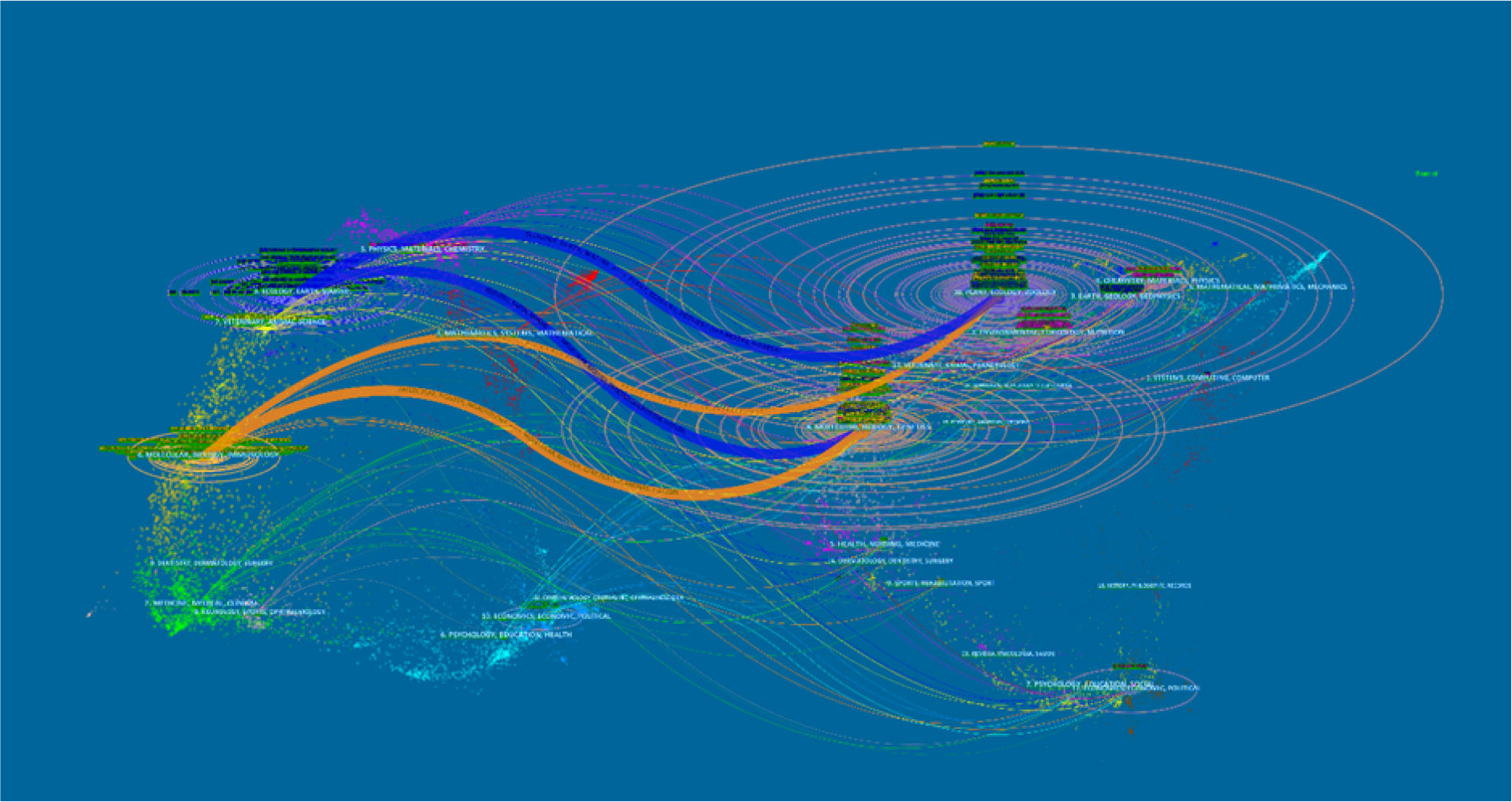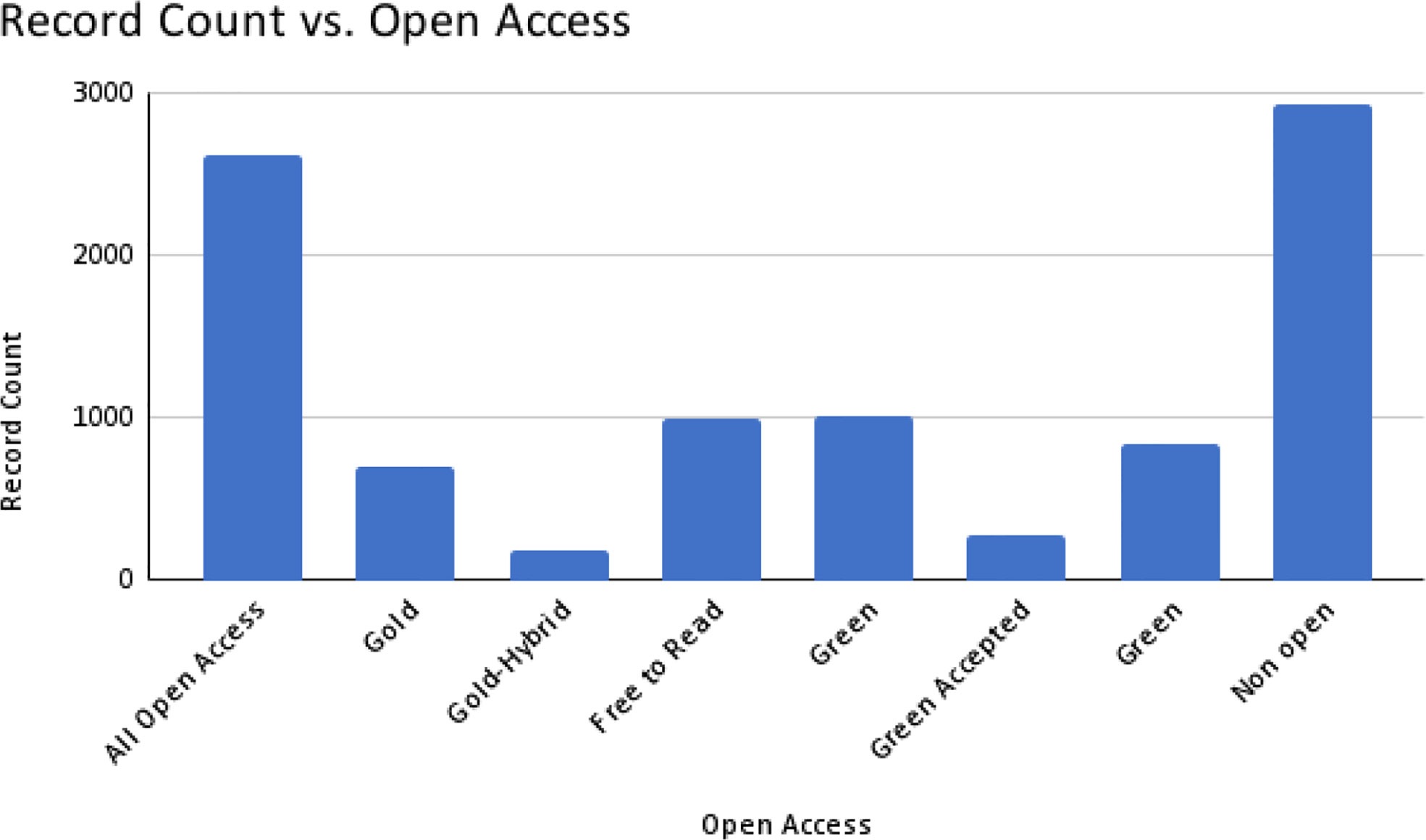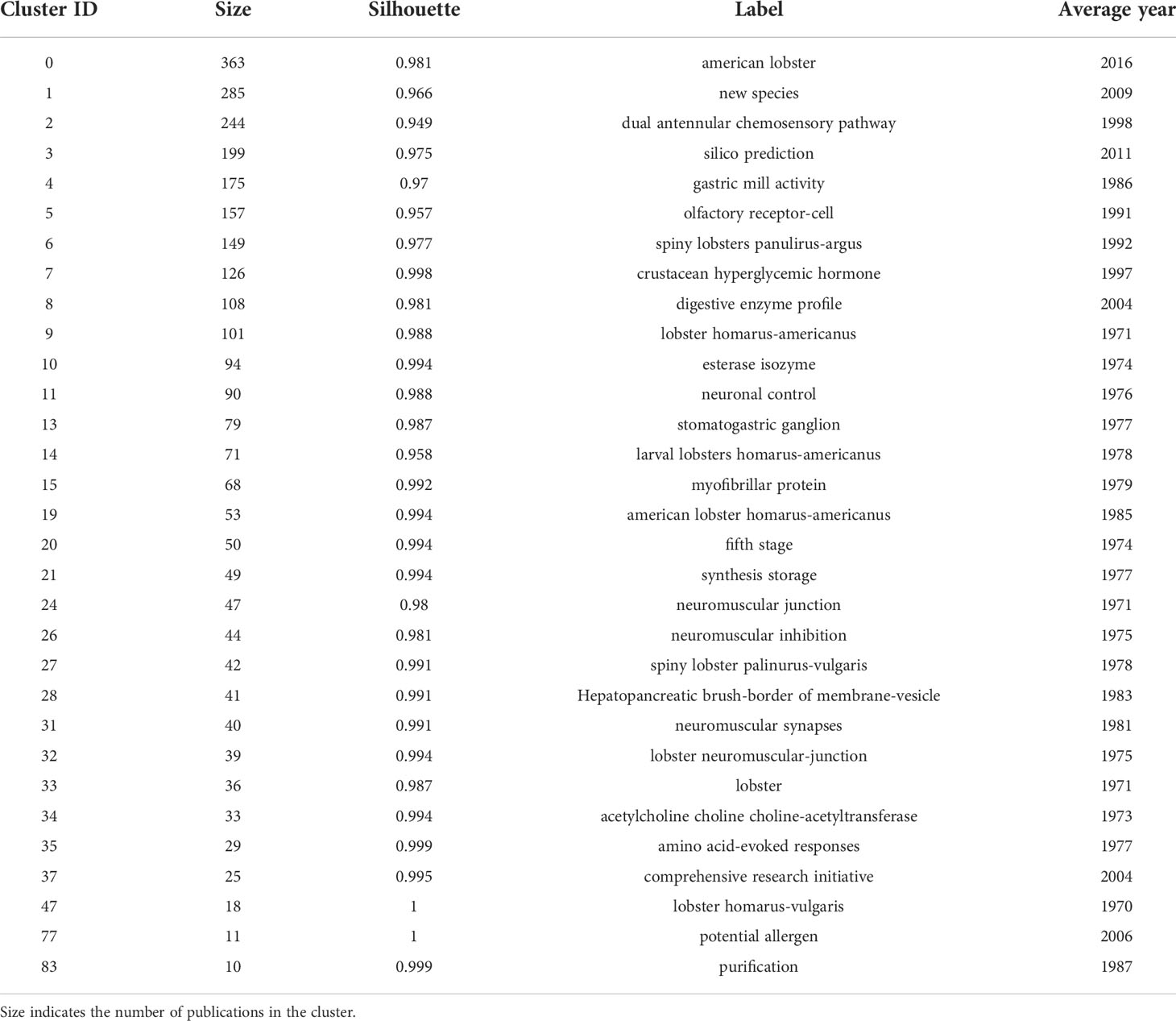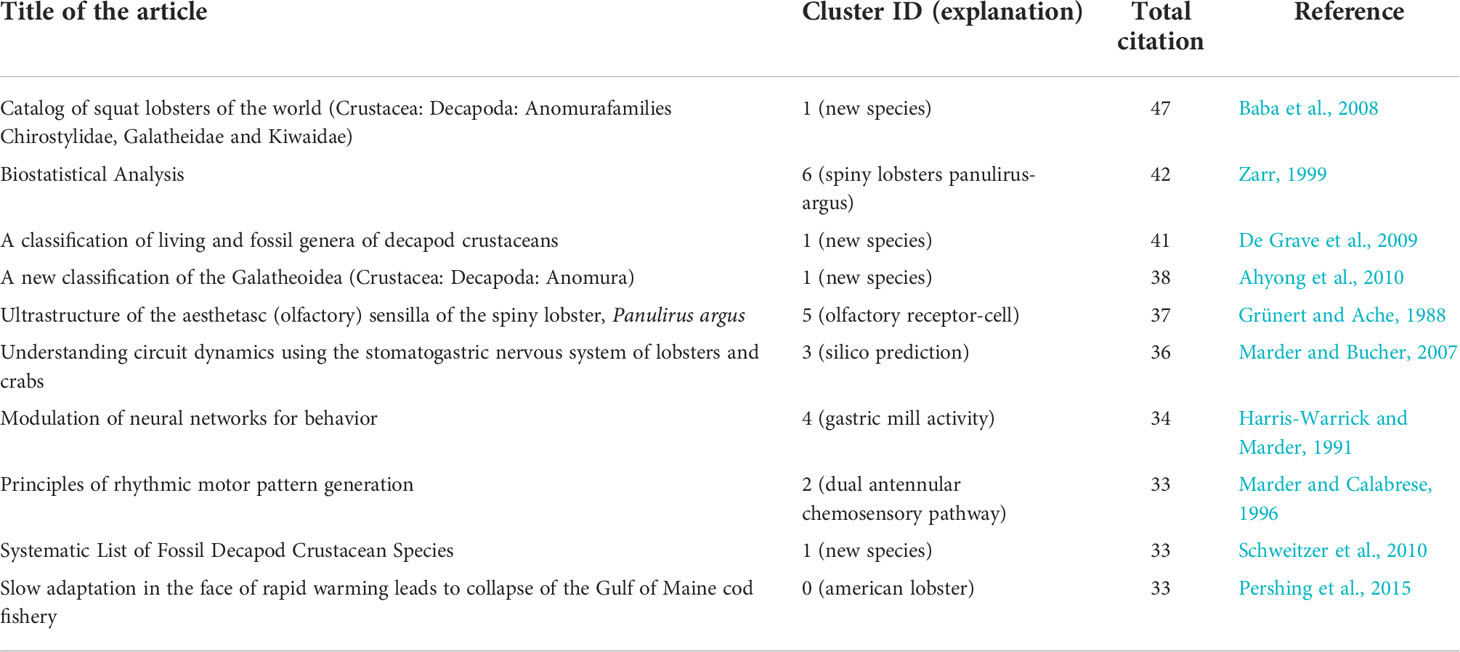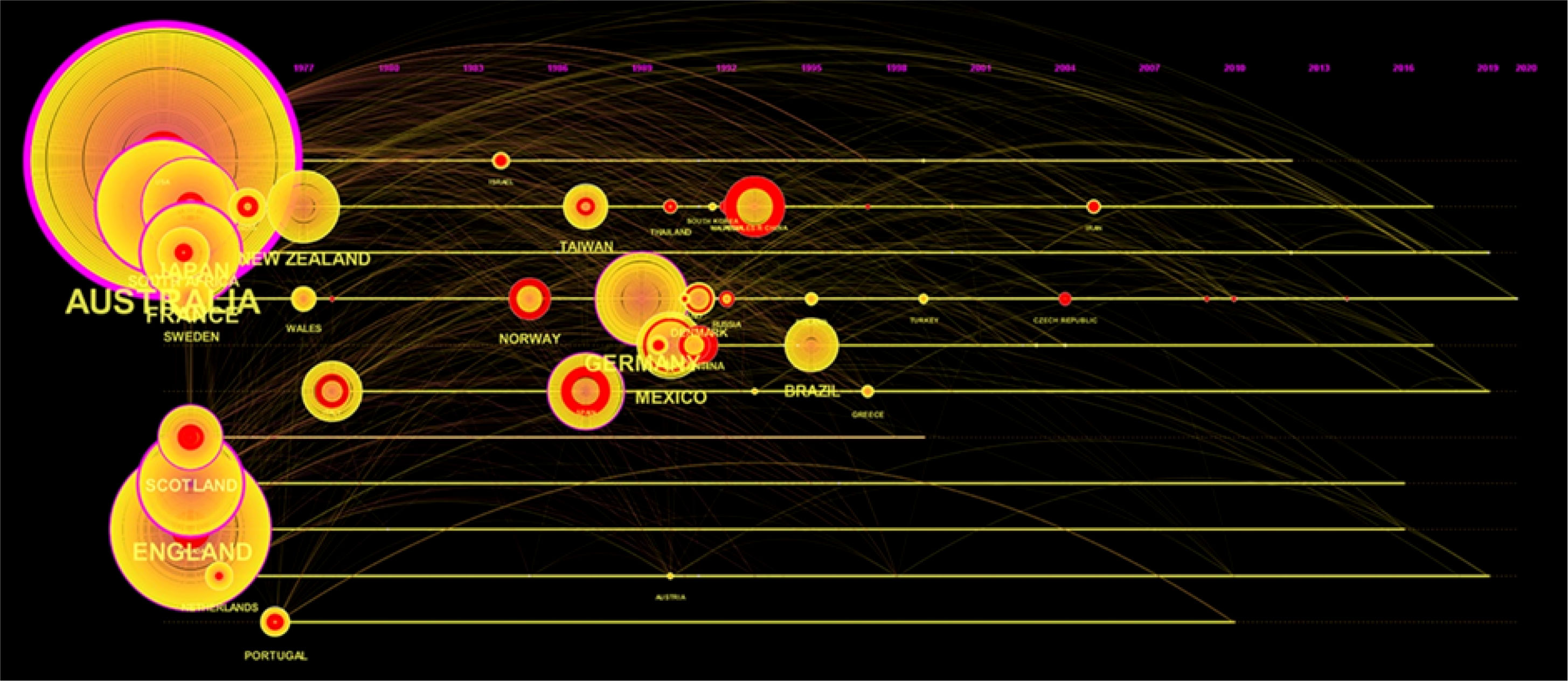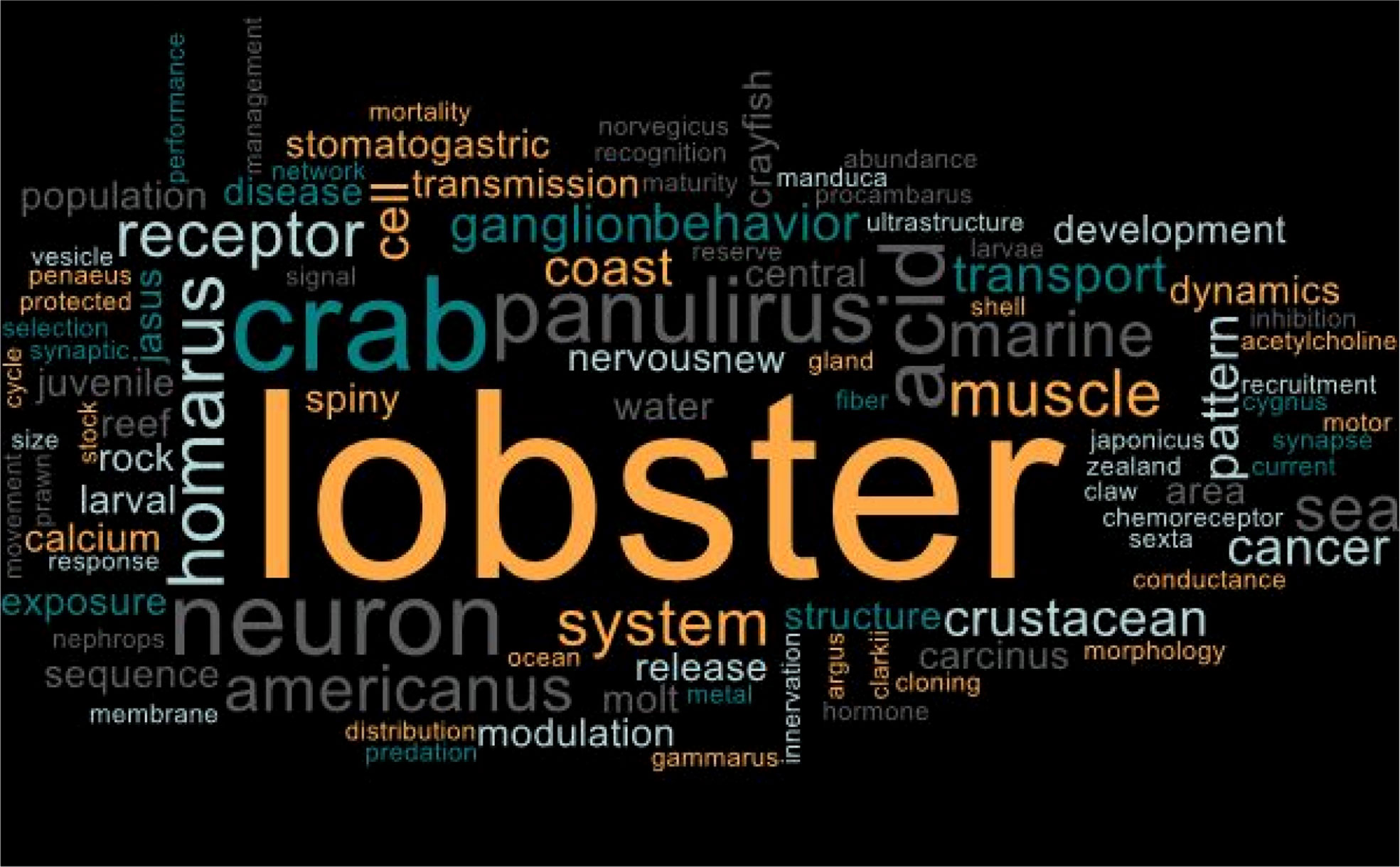- 1Institute of Marine Biotechnology (IMB), Universiti Malaysia Terengganu (UMT), Kuala Nerus, Malaysia
- 2Climate Change Adaptation Laboratory, Institute of Marine Biotechnology (IMB), Universiti Malaysia Terengganu (UMT), Kuala Nerus, Malaysia
- 3Department of Animal and Aquatic Sciences, Faculty of Agriculture, Chiang Mai University, Chiang Mai, Thailand
- 4Institute of Chemistry, University of Tartu, Tartu, Estonia
- 5Institute for Biodiversity and Sustainable Development, Universiti Teknologi MARA (UiTM), Shah Alam, Malaysia
- 6Faculty of Business Management, Universiti Teknologi MARA (UiTM) (Pahang), Raub, Malaysia
This study examined research and development of the commercially important marine lobster, in terms of descriptive metadata and scientometric analysis. We consider a collection of over 9,578 related articles to assess literature patterns and research development trends related to marine lobsters as a topic. Web of Science Core Collection was used to identify, collate, and generate publication trends, a list prominent authors and affiliations involved, countries that actively participated, and the co-citation analysis of the references as well as impactful articles and keywords. There were 149 different countries or states that had relevant publications on lobster research. We found an increase in the number of publications over time, with the USA having the most number of publications, followed by Australia and Canada. A total of 17,782 authors were involved in the field of lobster studies. Canadian researchers had the highest citation count for marine lobster research. Surprisingly, the most impactful keyword was crayfish, followed by neuron and amino acid sequence. Our study identifies the multidisciplinary nature in marine lobster research, which includes fields such as neuroscience and developmental genetics. We find that lobster scientific publications increasingly center on the broader coverage areas of science such as taxonomy and basic biology.
Introduction
Aquatic animals, such as shellfish, present an opportunity for future sustainable global food supply and food security (Azra et al., 2021; Dong et al., 2022). Marine lobster generally refers to the members of the suborder Macrura Reptantia, which is an unsettled natural group within the aquatic ecosystem (Chan, 2019). They are commonly huge in size, posing high economic value, making them among one of the most important marine resources for both fisheries and aquaculture sectors in the world. They are distributed in a variety of habitats, from tropical to temperate oceans, continental shelves, and even estuaries (Radhakrishnan et al., 2019; Cruz et al., 2021). The first recorded scientific publication of this lobster group was in 1895 (127 years ago), and the first recorded catch is over four centuries old, in 1605. This crustacean has attracted attention due to various reasons, for example, it is categorized as a key link in benthic marine ecosystems, acting as both prey and predator (Phillips, 2008; Koepper et al., 2021). The crustaceans also contribute to global aquaculture demand for seafood sources, in which their global market has reached a value of USD 5.66 billion in 2020 (FAO, 2021). Because of their high commodity value in most regions, they mostly provide employment and trading opportunities. As lobsters are captured in coastal and deep oceans in most countries around the world, they are among one of the most heavily exploited organisms, needing proper management and conservation to ensure sustainable fishing can continue (Radhakrishnan et al., 2005; Spanier et al., 2015; Eddy et al., 2017; Knutsen et al., 2022).
Much work has been done on the biological status, fishery activities, and aquaculture industry for marine lobsters (Jeffs and Hooker, 2000; Phillips and Matsuda, 2011; Radhakrishnan et al., 2019); they are even mentioned briefly in some previous scientometric studies (Kulkarni and Edwards, 2022). However, there are no scientometric studies published solely on marine lobsters. Most articles are more related to various issues of lobster biology and management aspects, rather than quantitative study of bibliometrics through scientometrics-based analysis. Some examples of current lobster research include lobster reproductive status and molting stage (Charmantier et al., 1991; Quackenbush, 1994; McWilliam and Phillips, 2007); their current distribution and biodiversity (Setyanto et al., 2018; Cruz et al., 2021), their history of utilization by human beings from prehistoric to the modern era (Spanier et al., 2015), their nutritional status for early stage of development (Williams, 2007; Francis et al., 2014), re-stocking and enhancement programs (Addison and Bannister, 1994), and their modern technical and husbandry innovations in culture have been made (Hinchcliffe et al., 2022).
Thus, the main purpose of our study is to determine the current pattern of research trends regarding marine lobster research in the world, using scientometric analysis. Specifically, we focused on publication trends, prominent authors and affiliations involved, countries that actively participated, and co-citation analysis of references as well as impactful articles and keywords. This will help identify research gaps, predicting future opportunities as well as further planning of grant applications on these organisms. We also expect our review to attract the attention of more researchers, especially postgraduate students and early career researchers, to become involved in this exclusively and valuable shellfish production in the future.
Survey methodology
Identification of search terms
Since there are a total of 260 species of lobster, with 54 different genera being recorded in the world, we decided not to list all species and genus names, instead only listing the common name of lobster in English, which is referred to as the lingua franca of the current scientific paper. The below list of marine lobster species names is based on the report published by FAO (1991) and a comprehensive taxonomy published by (Chan, 2010; Chan, 2019). The Boolean operator of OR was used for inclusion of all related terms used. An ‘∗’ refers to the additional letter if available during the searching activities. The search string is presented below.
Lobster: [(“lobster*”) OR (lobsterette) OR (“marine lobster*”) OR (“deepsea lobster*”) OR (“deep sea lobster*”) OR (“tropical lobster*”) OR (“clawed lobster*”) OR (“spiny lobster*”) OR (“mudspiny lobster*”) OR (“rock lobster*”) OR (“slipper lobster*”) OR (“sand lobster*”) OR (“reef lobster*”) OR (“blind lobster*”) OR (“furry lobster*”) OR (“scallop* lobster*”) OR (“scyllarid lobster*”) OR (“nephropid lobster*”) OR (“palinurid lobster*”) OR (“homarid lobster*”) OR (“polychelid lobster*”) OR (“shovel-nosed lobster*”) OR (“locust lobster*”) OR (“butterfly lobster*”) OR (“spear lobster*”) OR (“blunthorn lobster*”) OR (“mitten lobster*”) OR (“brown lobster*”) OR (“ocean lobsterette”) OR (“ridge-back lobsterette”) OR (“grooved lobsterette”) OR (“gladiator lobsterette”)].
Data sources, article search, and eligibility criteria
The Web of Science (Thomson Reuters) Core Collection (hereafter called WOSCC) was chosen for the systematic search strategy of the marine lobster’s literature. The WOSCC is specifically referred to as the leading peer-reviewed and high-quality database in the world, and it covers various disciplines (Aryadoust and Ang, 2021). Several inclusion and exclusions criteria, which are also known as eligibility criteria, were applied during the record screening. Firstly, the search was selected from the earliest available databases published by the WOSCC (1975) until the end of the year 2021. Secondly, the literature used for the present study was restricted to research articles, where we excluded non-article literature, such as conference papers, book chapters, review articles, abstract, letters, data papers, and correction papers. Thirdly, this study only includes articles in English, due to the limited scope of the study, timeline given, and funding acquisition of this project.
Data analysis
The descriptive dataset was analyzed using the web-based spreadsheet Google Docs Editors and Google Sheets. Scientometric analysis was used for the scientific publication network, using CiteSpace software (version 6.1.R2). This technique is commonly used for the identification of trends and patterns of selected research areas or themes (Chen, 2022). CiteSpace was also used to determine variable qualities of the final screening articles, by using degree (total number of citations from one to another author), centrality (most influential article), and sigma measurements (combination between centrality and burstiness score—sudden increase of total citation). CiteSpace’s input data came from WOSCC, as previously stated. Additionally, all term sources, including title, abstract, author keywords, and keywords plus, are chosen during text processing.
Results
Dual map overlay
A dual-map overlay of lobster research articles is shown in Figure 1 below. This map detects the most productive fields that conduct research in the lobster domain (left side) and the intellectual subfields in the domains (right side). The nodes on the left side are articles within the domain, while the right side contains articles cited by the left nodes. The curves are based on the number of citations (thicker line equal to high number of citations), while the ellipsoids indicate the number of active citations and journals in the field that focus on lobster research (bigger ellipsoids equal to highly active domains).
Type of open-access articles related to the lobster domain
A total of 2,931 articles were not considered open access (Figure 2), which means almost 70% of lobster research articles published between 1970 to 2021 are categorized as open access.
Publication trends
All descriptive details are shown in Supplementary Materials SA1, such as total publications over time, top authors list, top affiliations, and productive journals. Between 1970 and 2021, we identified a total of 9,578 articles published regarding marine lobster research. After sudden increases in 1990, the number of articles gradually grew but fluctuated from year to year, especially during 2009 and 2015. The highest number of published articles was recorded in 2020, with a total of 364 articles.
Productive author
Results showed that Charles D. Derby from Georgia State University, USA, was the top productive author in terms of published articles (n = 95) for marine lobster research in the world, based on the WOS database. A total of 17,782 total authors were involved and wrote at least one article in this lobster research. The other top 10 authors included Eve Marder, Chhabi K. Govind, Barry W. Ache, Douglas M. Neil, Tin-Yam Chan, Jelle Atema, Andrew E. Christie, Caleb Gardner, and Gregory A. Ahearn.
Top institutions
There were a total of 25 institutions that published at least 100 articles about lobster research in the world, based on data in WOSCC. The University of California System in the United States of America was the most prolific publisher, with 379 publications, followed by Fisheries Oceans Canada (328 publications), and The League of European Research Universities (LERU), a network of 23 leading research-intensive universities based in 12 countries around Europe (328 publications).
Productive journals
We found eligible articles in 1,450 journals in total, with the Journal of Experimental Biology having the most publications with 293 articles. Marine Ecology Progress Series was the second most productive journal in this topic (252), followed by Journal of Crustacean Biology (243), Aquaculture (223), Fisheries Research (221), Journal of Experimental Marine Biology and Ecology (215), Journal of Neurophysiology (185), Crustaceana (177), Canadian Journal Of Fisheries And Aquatic Sciences (172), and Marine Biology (162).
Regional distribution
There were 149 different countries that had relevant publications on lobster research (Figure 3). Among these countries, USA, Australia, and Canada were ranked as the three top countries. Our results also indicated that 75% of the countries in the world (149/195) are actively conducting research on this valuable crustacean species topic.
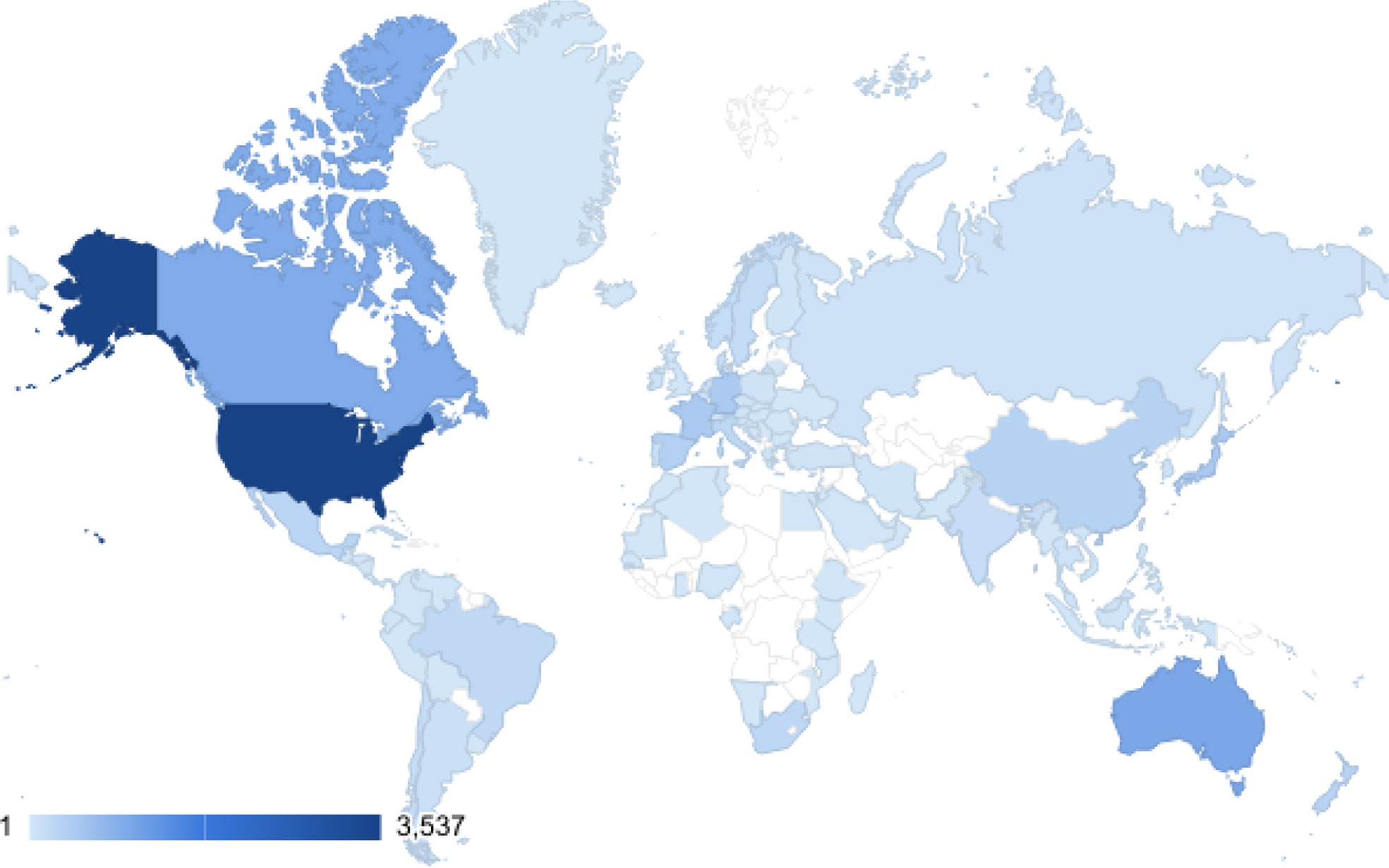
Figure 3 Total publications per nation for crayfish research; dark blue represents the highest total number of publications (n = 3,537), whereas lighter shades represent fewer publications. Countries that have not yet contributed to this field are displayed in white.
Scientometric results
The scientometric results can be divided into three main groups: (i) the co-citation analysis which includes author, journal, and document co-citation analysis; (ii) the document and 10-year research cluster analysis; and (iii) the country, article, and keywords burstiness.
Author co-citation analysis
Basically, co-citation analysis produces a graphical knowledge map with nodes (usually in the form of a lump or swelling), connections, and values that represent the main structure of the pattern of the variable’s quality (as mentioned previously in the Data Analysis section) changes over time. Figure 4 shows the list of authors with a centrality score greater than or equal to 0.1, with 11 total important authors (i.e., most interconnected authors) categorized as authors for co-citation analysis. The top two most central authors (based on centrality score) were David E. Aiken and James E. Stewart, both from Fisheries and Oceans Canada, St Andrews, Canada, with centrality scores of 0.25 and 0.23, a degree of connection of 56 and 25, and a sigma score of 4.25 and 10.25, respectively. However, based on the Sigma score, the top author is Francis Hobart Herrick, from Adelbert College of Western Reserve University, USA, with an exceptional sigma score equal to 1,071.83, showing that he is the most influential author in lobster research in the world. Table 1 shows the top 10 most influential authors in the field of lobster research.
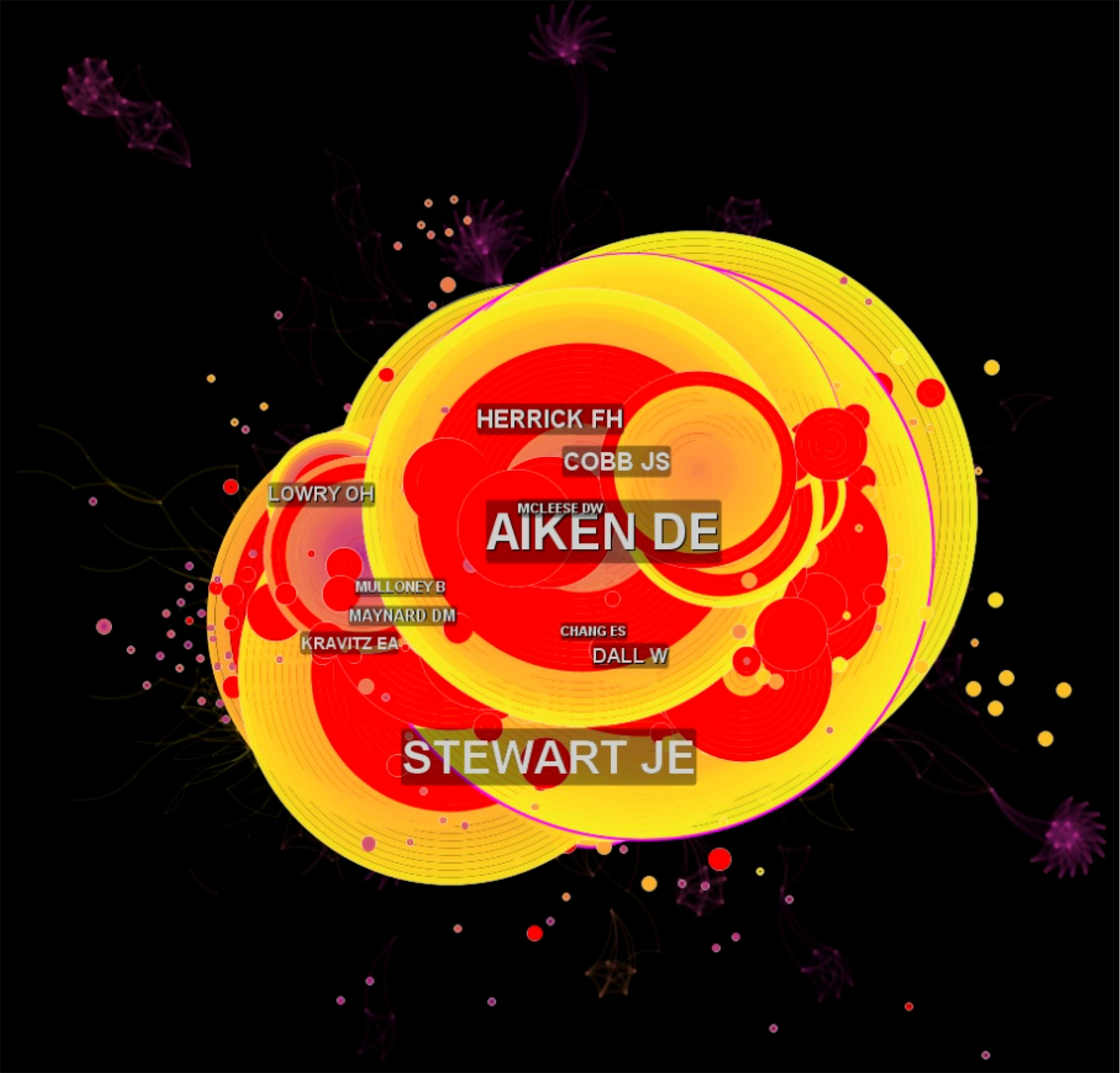
Figure 4 Network of author co-citation, with the bigger writing format of the author’s name indicating the most cited author (most referred) in lobster research.

Table 1 Top 10 most influential authors in marine lobster research, based on sigma score, organized in a descending manner.
Journal co-citation analysis
The knowledge map for the journal co-citation analysis is shown in Figure 5, where only journals with centrality scores greater than 0.1 are included. With a degree score of 35, a centrality score of 0.2, and a sigma score of 3.21, the Journal of the Fisheries Research Board of Canada, or currently known as Canadian Journal of Fisheries and Aquatic Sciences, was the most influential journal in lobster research. There were a total of 17 journals that have been considered as the most influential journals in lobster research, worldwide (with centrality scores ≥0.1). Journal of Experimental Zoology was also considered as the second-most influential journal. Table 2 shows the journal degree, centrality, and sigma score for the top 10 journals with the greatest influence, along with their 2021 journal impact factor (JCR). Journal of Experimental Zoology and PLOS One were the top two journals with tremendous sigma scores compared to the other journals.

Figure 5 The knowledge maps for journal co-citation analysis. The larger the formatted name of the journal, the more influential it was in lobster research.
Document citation analysis
Figure 6 illustrates the network of document co-citation analysis, where only articles with a centrality score of more than 0.1 were included in the analysis. There were a total of 17 influential articles in lobster research based on centrality score (≥0.1). With a sigma score of 10.07, a degree score of 24, and a centrality of 0.12, a review article published in Annual Review of Physiology, titled “Understanding circuit dynamics using the stomatogastric nervous system of lobsters and crabs”, was the most influential article in the selected theme of lobster research. The other two most influential articles in lobster research had sigma scores of 7.56 and 6.04, and belonged to Physiological Reviews (2021 JCR: 37.312) and Nature (2021 JCR: 49.962) journals, respectively.
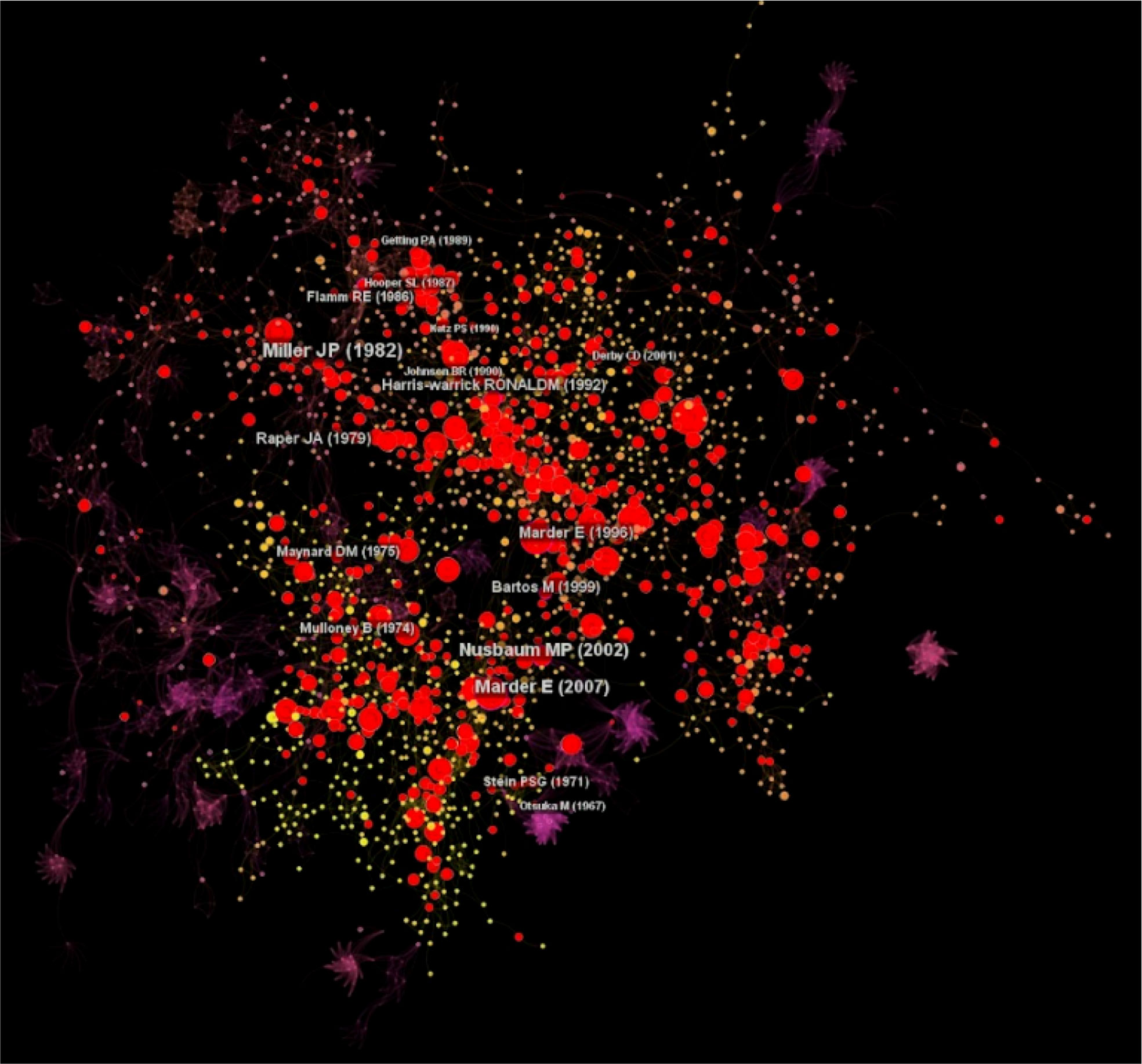
Figure 6 Network of document co-citation analysis, where articles with a centrality score greater than 0.1 are shown.
Ten-year research cluster analysis
A progress on lobster research through a 10-year basis showed an exponential phase of research activities and development (Figure 7). It shows the network of documents focusing on lobster research divided by phase from 1970 to 2021. There are five phases overall, which shows that the number of burst articles (red dots) gets higher for each phase. In network A (1970–1979), there are few burst articles (i.e., fewer red dots), whereas network E (2010–2021) is dominated by burst articles (Figure 7).
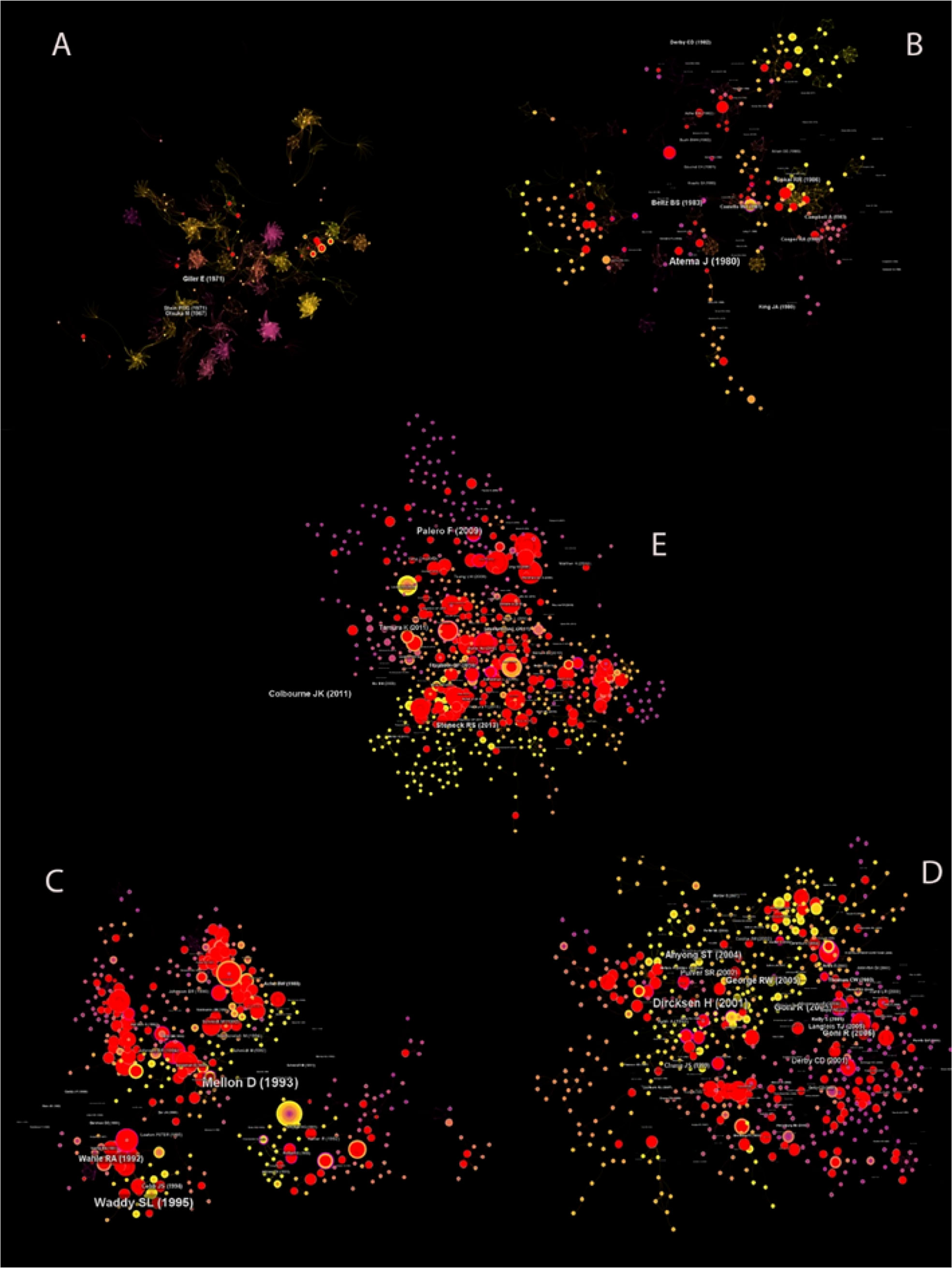
Figure 7 Ten-year intervals of lobster research (A) 1970 to 1979, (B) 1980 to 1989, (C) 1990–1999, (D) 2000–2009, and (E) 2010 to 2021.
Document cluster analysis
The document cluster analysis indicated the main field with potential to grow, or in other words the focus cluster with above-average network reliability and homogeneity. The analysis resulted in a total of 31 co-citation clusters which are summarized in Table 3, with the 14 most influential clusters being included in document cluster lifetimes on a horizontal line in Figure 8. The clusters were numbered and ranked in order of size, with #0 being the largest and #83 the smallest. The solid yellow line within each cluster represents the cluster’s lifetime; text mining and a keyword analysis algorithm in CiteSpace software were used to generate the cluster labels, and the log likelihood ratio was used to name these clusters (LLR). The number of publications in the cluster determines its size (referred to as “Size” in Table 3), where each cluster represents a different research topic. Cluster silhouette scores ranged from 0.949 to 1.0, indicating a high level of similarity among publications within each cluster. Cluster #0 (labeled as american lobster) had the most publications (n = 363 publications).
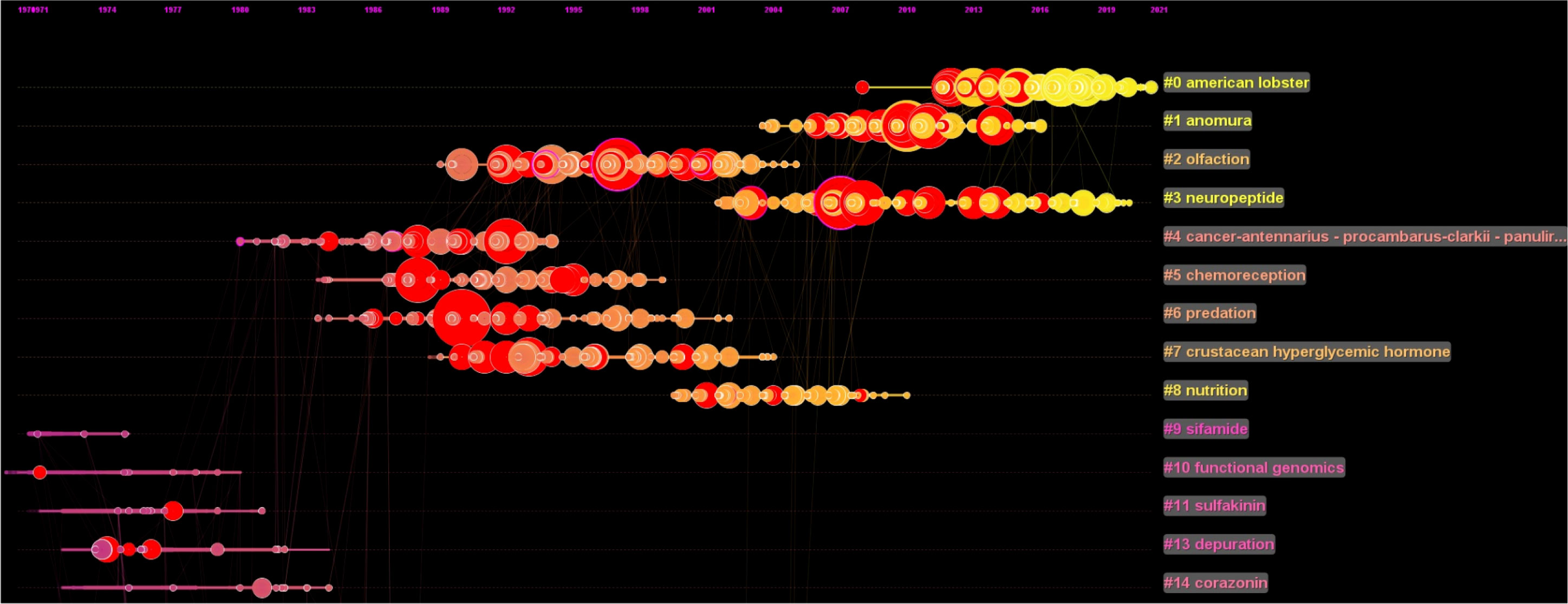
Figure 8 Summary of 14 identified document cluster lifetimes (solid lines). Cluster labels were generated from CiteSpace.
The top 10 highest citations received by an article in the lobster research theme is shown in Table 4. The results indicated that Baba et al. (2008) received the highest citation count which is published in the most recognized taxonomy journal, Zootaxa. Surprisingly, the study entitled “Slow adaptation in the face of rapid warming leads to collapse of the Gulf of Maine cod fishery” was the only study among the top 10 highest-cited publications that fell into cluster #0, even though this paper is not directly about marine lobsters (Table 4).
Country burstiness
Figure 9 shows the country-based burstiness, which showed that the majority of the countries with high burstiness are in the 70s era. In contrast, in the 2000s the countries with high bursts were Iran and the Czech Republic.
Article and keywords burstiness
The burst analysis was used to identify the most influential articles as well as keywords, to explore the trends among the related studies and keywords related to lobster research. In this section, there were two different types of burst, which were document bursts (also known as article burst) and keywords burst. The top 10 lobster research publications with the most powerful citation bursts are listed in Table 5, with the duration of each burst mentioned in the rightmost columns. The timeline (from 1970 to 2021) is represented by the blue line, while the burst period is represented by the red line. The emergence of a keyword in a publication during a specific time period is referred to as a burst. Meanwhile, the keywords that are related to lobster research with the highest citation burst are listed in Table 6. The article “The Achilles heel for spiny lobsters: the energetics of the non-feeding post-larval stage” (strength = 17.73; burst begin 2014 end 2019) is the most recent burst. The article was authored by Fitzgibbon et al. (2014) and published under the journal of Fish and Fisheries. The article “A classification of living and fossil genera of decapod crustaceans” had the strongest burst with 24.2. This study was published by De Grave et al. (2009) in the journal of Raffles Bulletin of Zoology.
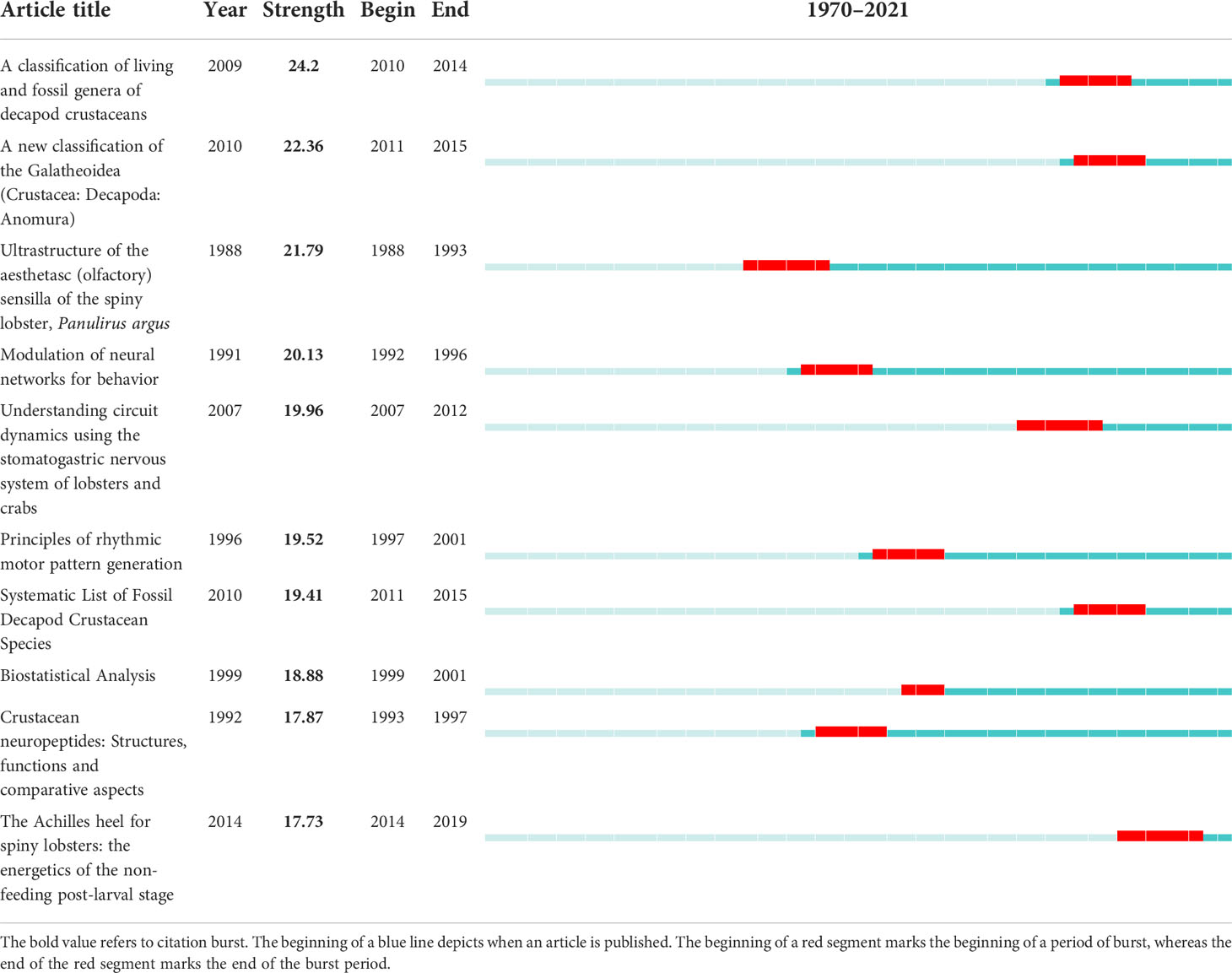
Table 5 Top 10 publications with the strongest citation burst in marine lobster research between 1970 and 2021.
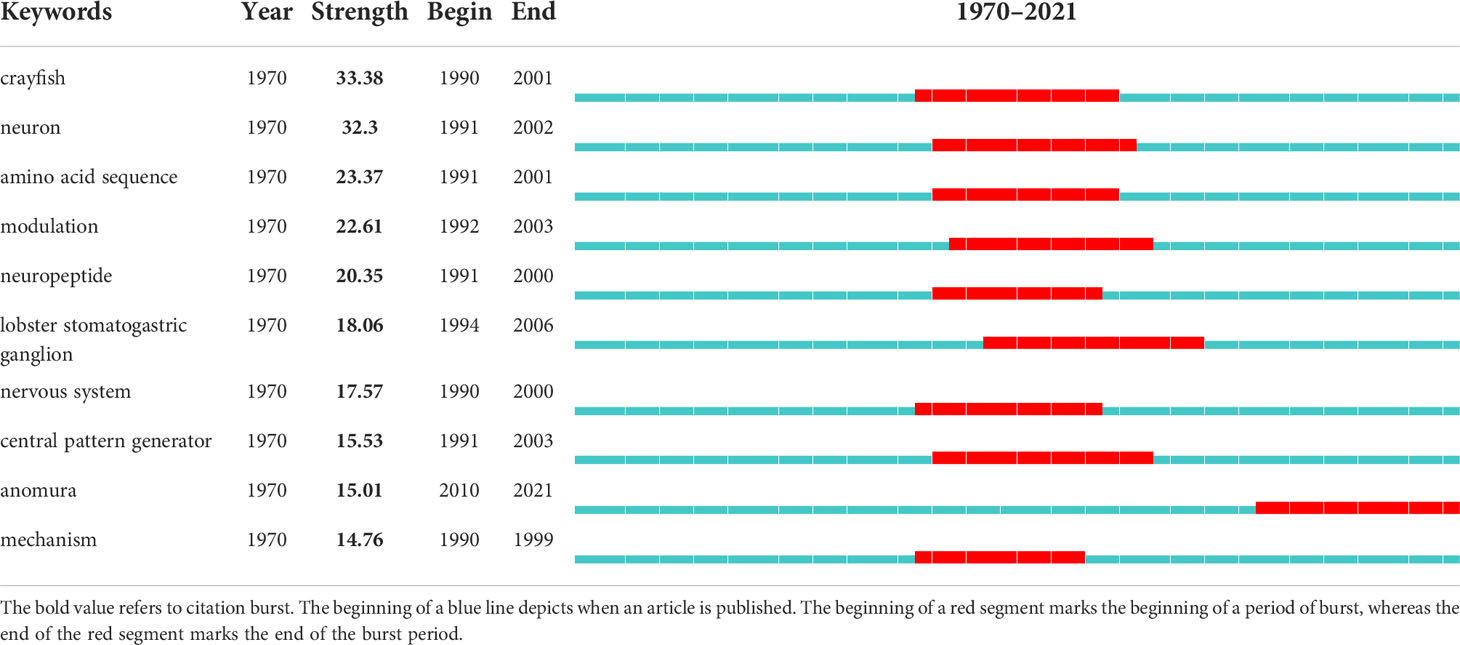
Table 6 Top 10 keywords with the strongest citation burst in marine lobster research published between 1970 and 2021 .
The keyword burst can be used to spot emerging patterns and research trends because each burst represents the appearance of a keyword in the selected subject area during a specific time period. As above, timelines (from 1970 to 2021) are represented by the blue line, while the burst period is represented by red lines. The term “crayfish” had the strongest burst strength between 1990 and 2001. The most recent keyword burst is “Anomura” with a burst strength of 15.1 starting between 2010 and 2021. Additionally, most cited keywords found in WOSCC are also shown in Figure 10.
Discussion
Lobsters have become an important luxury seafood especially for first-tier cities in the world (Wang and Somogyi, 2020). Thus, any research on marine lobster is valuable to inform sustainable fishery management. Our study represents the first attempt to focus on the analysis of lobster research publications through scientometric analysis using CiteSpace software. Other studies have applied it to gain an overview of emerging research and development, such as thermal tolerance studies and aquaculture-related research (Noor et al., 2021; Azra et al., 2022). Our work shows that the scientometrics-based analysis can be useful to identify any potential growing subject, including aquatic animal research and development, not only certain selected knowledge. “Ecology, Earth, Marine” and “Molecular, Biology, Immunology” were the disciplines with the most publications in the lobster domain, while “Plant, Ecology, Zoology” and “Molecular, Biology, Genetics” had the highest number of citations. Based on our map, the lobster domain is a multidiscipline research area. However, the number of articles from other subfields needs to be brought to attention with respect to lobster research as well.
As shown in our results, the publication trends of lobster research have fluctuated, but publishing numbers were increasing from less than 100 articles in 1990 to 338 publications in 2021. However, our results also indicated that there were fluctuating trends on marine lobster research and publishing intensity, especially from 1996 until 2004. This might be related to the nature of the lobster’s biology. For example, because marine lobsters live at the bottom of the sea, this could be a problem for researchers to sample, which might affect the ability of researchers in the past to collect effective data. We expect that after 2004, sampling and aquaculture technologies in marine lobster research became better developed, thus reducing time periods for sampling lobsters and their broodstock (Mills and Crear, 2004; Smith et al., 2004).
Because lobsters have a worldwide distribution, most countries as well as authors or researchers in the world have been working on lobster research and development (>75%). However, we identified the keyword “crayfish” as the most impactful, and keywords such as “lobster” and “neuro” are among the cited keywords in the WOSCC database. Previous studies have shown that the most common name of crayfish has been used for freshwater species because they have the appearance of a marine lobster (Haubrock et al., 2021). Another reason for “crayfish” being an important keyword is because some of the lobster groups, such as the clawed lobsters (lived in the marine ecosystem), are more related to the other three families of freshwater crayfish (Toon et al., 2009; Chan, 2019). In addition, other countries, such as the United Kingdom and South Africa, refer to lobster as marine crayfish in their studies (Patak et al., 2006).
Why did Francis Hobart Herrick receive so much attention or a higher sigma score? The researcher from Adelbert College of Western Reserve University is a naturalist and history illustrator for his popular research on the American lobster life history, coming from the USA. Since most of the authors involved in lobster research are from North American countries, they might be more aware of articles from the same region. Additionally, Herrick’s work on American lobsters forms some of the first foundational knowledge about them, being published in 1911, and thus has had ample time to become well cited.
In terms of the highest citation counts received by an article in the lobster research theme, we identified a cluster named #new species gaining more attraction compared to other clusters in the scientometrics analysis. Our study suggests that this could be due to the fact that when new species are found, it will increase the attractiveness of other researchers to conduct new research using similar species. This could correspondingly influence the citation count for this cluster. However, most publications available (363 of the total 9,578) fell into Cluster #0 (labeled as american lobster), with 363 publications. This is not surprising since most of the articles came from the USA, as referred to the American lobster, thus increasing the chances of the respective keywords being mentioned in new publications.
When we compared the 10-year network progression between 1970 and 2021, we noted that the network got tighter over the years. Nodes within network A were far from each other, while in network E nodes were much closer together. This situation is due to the fact that most of the nodes are related to each other based on citations in network E. This of course makes sense in that over time as more lobster research articles are published, articles focusing on lobster research can cite more articles that also focus on lobster research. The number of articles is sufficient for us to state that this network is becoming one main research area. This macro view of burst articles indicates that lobster research is getting more recognizable over time.
Our results also showed that there were 12 articles in the scientometric-based analysis that had the highest citation count or were most influential publications in lobster research (Grünert and Ache, 1988; Harris-Warrick and Marder, 1991; Keller, 1992; Marder and Calabrese, 1996; Zarr, 1999; Marder and Bucher, 2007; Baba et al., 2008; De Grave et al., 2009; Ahyong et al., 2010; Schweitzer et al., 2010; Fitzgibbon et al., 2014; Pershing et al., 2015). These studies can be divided into three main categories: lobster taxonomy-based studies (Baba et al., 2008; De Grave et al., 2009; Ahyong et al., 2010; Schweitzer et al., 2010), biological development and neurophysiology-related studies (Grünert and Ache, 1988; Harris-Warrick and Marder, 1991; Keller, 1992; Marder and Calabrese, 1996; Marder and Bucher, 2007), and others (e.g., aquaculture development and climate-related changes) (Fitzgibbon et al., 2014; Pershing et al., 2015). There was also a study not related to marine lobster research but was about statistical analysis in biological research and development using statistical tools for analysis (Zarr, 1999).
Within the taxonomy-based studies, most discussed the importance of the updated taxonomy status of marine lobster species. This helps contribute to the possible potential database for biological information of the species and can identify evolutionary relationships occurring in the future. There is also a need to ensure new researchers are able to collaborate with established members of the field, so that future research can have a solid foundation (Baba et al., 2008; De Grave et al., 2009; Ahyong et al., 2010; Schweitzer et al., 2010). For the biological development and neurophysiological studies, we noted most used lobster animals as their model organism. This might be due to the fact that there are similarities between lobster nervous systems and humans.
Among the studies receiving the highest citation burst according to the scientometric dataset (Fitzgibbon et al., 2014; Pershing et al., 2015), Pershing et al. (2015) published in Science indicating that managing lobster fisheries stocks under climate change is going to be increasingly problematic. On the other hand, Fitzgibbon et al. (2014) determined metabolic strategies of an early development stage in lobsters, the puerulus stage. These two papers being among the most cited is interesting because frequently lobsters are stocked at the puerulus stage, and Fitzgibbon et al. (2014) indicated that frequently there are insufficient endogenous energy reserves for juvenile survival. Taken together, they demonstrate that it will be important to understand how to maintain such energy reserves in the face of changing climates to ensure sustainable lobster fishery management.
Our analysis assessing the relationships between Burst, Degree, Centrality, and Sigma with Year Published was statistically significant (Sig. (2-tailed) = 0.00), which means that each variable had a non-spurious correlation. Although there was a correlation between year and burstiness, the correlation was not very strong. However, that we detected a correlation in each variable suggests that the earlier an article was published, the higher the citation count. While perhaps intuitive, it is important to know because future research may need to consider other factors to reach high citation rates and increase their visibility within lobster research.
Conclusion
In general, the lobster research was focused more on taxonomy and basic biologically based studies, and less on fisheries-based management. However, studies related to lobster culturing technologies were starting to become more apparent, especially for hatchery production of larval stages. Our work on this important animal integrated diverse and important topics, from the commercial production of lobster to work related to neuroscience and developmental genetics. As demands for lobster around the world are increasing, better fisheries stock management and increasing the aquaculture production, especially through increasing larval survival, are needed. Thus, any research on marine lobster, such as from scientometrics-based studies, is increasingly important to identify further research gaps and further development of the lobster industry. Future bibliometrics-related studies should consider using more stringent keyword searches and reviewing exported data manually to reduce the likelihood of irrelevant studies. Additional databases such as Scopus and PubMed to compare any literature or identify any missing vital information on lobster research would also be beneficial. Regardless, our study offers a comprehensive overview on the current body of research studying the trends and patterns of lobster research. There is a significant gap that requires further investigation and international collaboration.
Perspective
Lobster research is important for fisheries and aquaculture sectors and provides direction for aquaculturists, fishermen, philanthropists, academics, and government and non-government organizations on how to invest limited resources in policies, programs, and research toward the future management of this animal. Any approaches that assesses current lobster research are also of great importance as they can guide future research suggestions based on identified research gaps. This review can also provide valuable information about lobsters and their habitat, to ensure studies of contaminated habitats can be conducted.
Author contributions
MNA: first draft, revised version, final approval of the version to be published. MJ: literature search and data analysis, final approval of the version to be published. HD: literature search and data analysis, final approval of the version to be published. IZ: literature search and data analysis; drafting the work or revising it critically for important intellectual content, final approval of the version to be published. MFA: drafting the work or revising it critically for important intellectual content, final approval of the version to be published. ZL: literature search and data analysis, final approval of the version to be published. MN: second drafting the work or revising it critically for important intellectual content, final approval of the version to be published. All authors contributed to the article and approved the submitted version.
Funding
The funding was received through PYPA Initiative managed by the Universiti Teknologi MARA (UiTM). (PYPA in Malay: Pembiayaan Yuran Penerbitan Artikel).
Conflict of interest
The authors declare that the research was conducted in the absence of any commercial or financial relationships that could be construed as a potential conflict of interest.
Publisher’s note
All claims expressed in this article are solely those of the authors and do not necessarily represent those of their affiliated organizations, or those of the publisher, the editors and the reviewers. Any product that may be evaluated in this article, or claim that may be made by its manufacturer, is not guaranteed or endorsed by the publisher.
Supplementary material
The Supplementary Material for this article can be found online at: https://www.frontiersin.org/articles/10.3389/fmars.2022.976199/full#supplementary-material
References
Addison J. T., Bannister R. C. A. (1994). Re-stocking and enhancement of clawed lobster stocks: A review. Crustaceana 67 (2), 131–155. doi: 10.1163/156854094X00521
Ahyong S. T., Baba K., Macpherson E., Poore G. C. B. (2010). A new classification of the galatheoidea (Crustacea: Decapoda: Anomura). Zootaxa 2676, 1, 15. doi: 10.11646/zootaxa.2676.1.4
Aryadoust V., Ang B. H. (2021). Exploring the frontiers of eye tracking research in language studies: a novel co-citation scientometric review. Comput. Assisted Lang. Learning 34, 898–933. doi: 10.1080/09588221.2019.1647251
Azra M. N., Noor M. I. M., Sung Y. Y., Dawood M. A. O., Ghaffar M. A. (2022). Trends and developments in thermal tolerance: A scientometric research study. J. Thermal Biol. 106, 103234. doi: 10.1016/j.jtherbio.2022.103234
Azra M. N., Okomoda V. T., Tabatabaei M., Hassan M., Ikhwanuddin M. (2021). The contributions of shellfish aquaculture to global food security: Assessing its characteristics from a future food perspective. Front. Mar. Sci. 8, 654897. doi: 10.3389/fmars.2021.654897
Baba K., Macpherson E., Poore G., Ahyong C. B., Bermudez S. T., Cabezas A., et al. (2008). Catalogue of squat lobsters of the world (Crustacea: Decapoda: Anomura-families chirostylidae, galatheidae and kiwaidae). Zootaxa 1905 (1), 1–220. doi: 10.11646/zootaxa.1905.1.1
Chan T.-Y. (2010). Annotated checklist of world’s marine lobsters (Crustacea, decapoda: Astacidea, glypheida, achelata, polychelida). Raffles Bull. Zool. 23, 153–181.
Updated Checklist of the World’s Marine Lobsters. In: Radhakrishnan E., Phillips B., Achamveetil G. (eds) Lobsters: Biology, Fisheries and Aquaculture. Singapore: Springer. doi: 10.1007/978-981-32-9094-5_2
Charmantier G., Charmantier-Daures M., Aiken D. E. (1991). Metamorphosis in the lobster homarus (Decapoda): A review. J. Crustacean Biol. 11 (4), 481–495. doi: 10.2307/1548517
Chen C. (2022) How to use CiteSpace (6.1.R2): 137 (Victoria, Canada: Lean Publishing). Available at: http://leanpub.com/howtousecitespace (Accessed 22.06.2022).
Cruz R., Torres M. T., Santana J. V. M., Cintra I. H. A. (2021). Lobster distribution and biodiversity on the continental shelf of Brazil: A review. Diversity 13 (11), 507. doi: 10.3390/d13110507
De Grave S., Pentcheff N. D., Ahyong S. T., Chan T.-Y., Crandall K. A., Dworschak P. C., et al. (2009). A classification of living and fossil genera of decapod crustaceans. Raffles Bull. Zool. 21 Supplement, 1–109.
Dong S., Wang F., Zhang D., Yu L., Pu W., Shang Y. (2022). Growth performance and ecological services evaluation of razor clams based on dynamic energy budget model. J. Environ. Manage. 306 (15), 114392. doi: 10.1016/j.jenvman.2021.114392
Eddy T. D., Araújo J. N., Bundy A., Fulton E. A., Lotze H. K. (2017). Effectiveness of lobster fisheries management in New Zealand and Nova Scotia from multi-species and ecosystem perspectives. ICES J. Mar. Sci. 74 (1), 146–157. doi: 10.1093/icesjms/fsw127
FAO (1991) FAO species catalogue vol. 13 marine lobsters of the world. Available at: http://www.fao.org/3/a-t0411e.pdf.
FAO (2021) Lobster market seeing strong recovery. Available at: https://www.fao.org/in-action/globefish/market-reports/resource-detail/en/c/1460140/ (Accessed 16th June 2022).
Fitzgibbon Q. P., Jeffs A. G., Battaglene S. C. (2014). The Achilles heel for spiny lobsters: the energetics of the non-feeding post-larval stage. Fish and Fisheries 15, 2, 312–326. doi: 10.1111/faf.12018
Francis D. S., Salmon M. L., Kenway M. J., Hall M. R. (2014). Palinurid lobster aquaculture: nutritional progress and considerations for successful larval rearing. Rev. Aquacult. 6 (3), 180–203. doi: 10.1111/raq.12040
Grünert U., Ache B. W. (1988). Ultrastructure of the aesthetasc (olfactory) sensilla of the spiny lobster, panulirus argus. Cell Tissue Resesrch 251, 95–103. doi: 10.1007/BF00215452
Harris-Warrick R. M., Marder E. (1991). Modulation of neural networks for behavior. Annu. Rev. Neurosci. 14, 39–57. doi: 10.1146/annurev.ne.14.030191.000351
Haubrock P. J., Oficialdegui F. J., Zeng Y., Patoka J., Yeo D. C. J., Kouba A. (2021). The redclaw crayfish: A prominent aquaculture species with invasive potential in tropical and subtropical biodiversity hotspots. Rev. Aquacult. 13, 1488–1530. doi: 10.1111/raq.12531
Hinchcliffe J., Agnalt A.-L., Daniels C. L., Drengstig A., Lund I., McMinn J., et al. (2022). European Lobster homarus gammarus aquaculture: Technical developments, opportunities and requirements. Rev. Aquacult. 14 (2), 919–937. doi: 10.1111/raq.12634
Jeffs A., Hooker S. (2000). Economic feasibility of aquaculture of spiny lobsters jasus edwardsii in temperate waters. J. World Aquacult. Soc. 31 (1), 30–41. doi: 10.1111/j.1749-7345.2000.tb00695.x
Keller R. (1992). Crustacean neuropeptides: Structures, functions and comparative aspects. Experientia 48, 439–448. doi: 10.1007/BF01928162
Knutsen J. A., Kleiven A. R., Olsen E. M., Knutsen H., Espeland S. H., Sørdalen T. K., et al. (2022). Lobster reserves as a management tool in coastal waters: Two decades of experience in Norway. Mar. Policy 136, 104908. doi: 10.1016/j.marpol.2021.104908
Koepper S., Revie C. W., Stryhn H., Clark K. F., Scott-Tibbetts S., Thakur K. K. (2021). Spatial and temporal patterns in the sex ratio of American lobsters (Homarus americanus) in Southwestern Nova Scotia, Canada. Sci. Rep. 11, 24100. doi: 10.1038/s41598-021-03233-8
Kulkarni S. S., Edwards D. J. (2022). A bibliometric review on the implications of renewable offshore marine energy development on marine species. Aquacult. Fish. 7, 211–222. doi: 10.1016/j.aaf.2021.10.005
Marder E., Bucher D. (2007). Understanding circuit dynamics using the stomatogastric nervous system of lobsters and crabs. Annu. Rev. Physiol. 69, 291–316. doi: 10.1146/annurev.physiol.69.031905.161516
Marder E., Calabrese R. L. (1996). Principles of rhythmic motor pattern generation. Physiol. Rev. 76 (3), 687–717. doi: 10.1152/physrev.1996.76.3.687
McWilliam P. S., Phillips B. F. (2007). Spiny lobster development: mechanisms inducing metamorphosis to the puerulus: A review. Rev. Fish Biol. Fish. 17, 615–632. doi: 10.1007/s11160-007-9067-5
Mills D., Crear B. (2004). Developing a cost-effective puerulus collector for the southern rock lobster (Jasus edwardsii) aquaculture industry. Aquacult. Engineering 31, 1–15. doi: 10.1016/j.aquaeng.2003.12.001
Noor M. I. M., Azra M. N., Lim V.-C., Zaini A. A., Dali F., Hashim I. M., et al. (2021). Aquaculture research in southeast Asia - a scientometric analysis, (1990-2019). Int. Aquat. Res. 13 (4), 271–288. doi: 10.22034/iar.2021.1932503.1166
Patak S. N., Feldman R. M., Porter M., Tshudy D. (2006). “Phylogeny and evolution,” in Lobsters: Biology, management, aquaculture and fisheries. Ed. Phillips B. F. (Oxford: Blackwell Scientific Publications), 113–145.
Pershing A. J., Alexander M. A., Hernandez C. M., Kerr L. A., Le Bris A., Mills K. E., et al. (2015). Slow adaptation in the face of rapid warming leads to collapse of the gulf of Maine cod fishery. Science 13; 350 (6262), 809–812. doi: 10.1126/science.aac9819
Phillips B. (2008). Lobsters: biology, management, aquaculture and fisheries. Singapore: John Wiley & Sons. pp 231–51.
Phillips B., Matsuda H. (2011). Recent advances and new species in aquaculture. In. Fotedar R.K., Philips B. F. Eds. A global review of spiny lobster aquaculture Oxford, United Kingdom: Blackwell Publishing. pp. 22–84. Available at: https://onlinelibrary.wiley.com/doi/epdf/10.1002/9781444341775.ch2.
Quackenbush L. S. (1994). Lobster reproduction: A review, crustaceana 67, 1, 82–94. doi: 10.1163/156854094X00323
Radhakrishnan E. V., Deshmukh V. D., Manisseri M. K., Rajamani M., Kizhakudan J. K., Thangaraja R. (2005). Status of the major lobster fisheries in India. New Z. J. Mar. Freshw. Res. 39 (3), 723–732. doi: 10.1080/00288330.2005.9517348
Radhakrishnan E. V., Phillips B. F., Achamveetil G. (2019). Lobsters: biology, fisheries and aquaculture. Singapore: Springer. (pp. 409–517). doi: 10.1007/978-981-32-9094-5
Schweitzer C. E., Feldmann R. M., Garassino A., Karasawa H., Schweigert G. (2010). Systematic list of fossil decapod crustacean species. Crustaceana Monogr. 10, 1–222. Brill, Boston.
Setyanto P., Pramono A., Adriany T. A., Susilawati H. L., Tokida T., Padre A. T., et al. (2018). Alternate wetting and drying reduces methane emission from a rice paddy in Central Java, Indonesia without yield loss. Soil Sci. Plant Nutrition 64 (1), 23–30. doi: 10.1080/00380768.2017.1409600
Setyanto A., Sambah A. B., Widhiastika D., Soemarno Wiadnya D. G.R., Prayogo C.(2020) Species composition of puerulus spiny lobsters from the South Sea of Pacitan of East Java, Indonesia. IOP Conf. Ser. Earth Environ. Sci. 493, 919 012015.
Smith G. G., Ritar A., Johnston D., Dunstan G. A. (2004). Influence of diet on broodstock lipid and fatty acid composition and larval competency in the spiny lobster, jasus edwardsii. Aquaculture 233, 451–475. doi: 10.1016/j.aquaculture.2003.11.009
Soemarno A. S., Wiadnya D. G. R., Nugroho C. (2019). Species composition of puerulus spiny lobsters from the South Sea of Pacitan of East Java, Indonesia. IOP Conf. Ser.: Mater. Sci. Eng. 546, 2. doi: 10.1088/1757-899X/546/2/022024
Spanier E., Lavalli K. L., Goldstein J. S., Groeneveld J. C., Jordaan G. L., Jones C. M., et al. (2015). A concise review of lobster utilization by worldwide human populations from prehistory to the modern era. ICES J. Mar. Sci. 72: Issue suppl _1, i7–i21. doi: 10.1093/icesjms/fsv066
Toon A., Finley M., Staples J., Crandall K. A. (2009). “Decapod phylogenetics and molecular evolution,” in Crustacean issues 18: Decapod crustacean phylogenetics (15–29). Eds. Martin J. W., Crandall K. A., Felder D. L. (Boca Raton: Taylor & Francis/CRC Press).
Wang O., Somogyi S. (2020). Motives for luxury seafood consumption in first-tier cities in China. Food Qual. Preference 79, 103780. doi: 10.1016/j.foodqual.2019.103780
Williams K. C. (2007). Nutritional requirements and feeds development for post-larval spiny lobster: A review. Aquaculture 263(1–4), 1–14. doi: 10.1016/j.aquaculture.2006.10.019
Keywords: aquatic, bibliometrics, homarus, jasus, panulirus, scientometrics
Citation: Azra MN, Jye MW, Van Doan H, Zekker I, Abdullah MF, Abd Latif Z and Noor MIM (2022) Mapping of marine lobster research: A global outlook. Front. Mar. Sci. 9:976199. doi: 10.3389/fmars.2022.976199
Received: 23 June 2022; Accepted: 29 July 2022;
Published: 02 September 2022.
Edited by:
S.S.S. Sarma, Universidad Nacional Autónoma de México, MexicoReviewed by:
Brenda Karen González Pérez, Technological University of the Metropolitan Area of Valle de México, MexicoPedro Ramírez García, National Autonomous University of Mexico, Mexico
Copyright © 2022 Azra, Jye, Van Doan, Zekker, Abdullah, Abd Latif and Noor. This is an open-access article distributed under the terms of the Creative Commons Attribution License (CC BY). The use, distribution or reproduction in other forums is permitted, provided the original author(s) and the copyright owner(s) are credited and that the original publication in this journal is cited, in accordance with accepted academic practice. No use, distribution or reproduction is permitted which does not comply with these terms.
*Correspondence: Mohamad Nor Azra, YXpyYW1uQHVtdC5lZHUubXk=; Mohd Iqbal Mohd Noor, bW9oZGlxYmFsbW5AdWl0bS5lZHUubXk=
 Mohamad Nor Azra
Mohamad Nor Azra Mok Wen Jye
Mok Wen Jye Hien Van Doan
Hien Van Doan Ivar Zekker
Ivar Zekker Muhammad Fuad Abdullah
Muhammad Fuad Abdullah Zulkiflee Abd Latif
Zulkiflee Abd Latif Mohd Iqbal Mohd Noor
Mohd Iqbal Mohd Noor